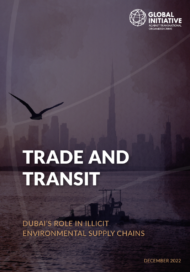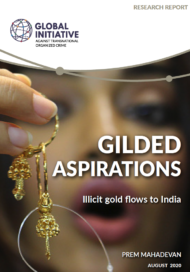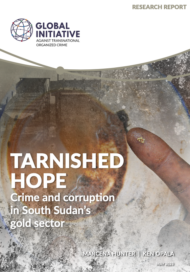Posted on 14 Dec 2022
The UN Climate Change Conference (CoP27), held in Egypt in November, once again highlighted the need to accelerate global climate action. Core to realizing a lower-carbon future are clean technologies. As demand for clean energy technologies increases, so will demand for the minerals required to make these technologies possible. Yet, despite the attention green minerals are currently receiving, the potential impacts of organized crime on the sector appears to remain a blind spot.
Green minerals (also known as clean energy metals, energy transition minerals and critical minerals) play a key role in efforts to decarbonize by shifting sources away from fossil fuels to renewable energy. A wide range of minerals fall under the umbrella of green minerals, including cobalt, lithium, rare earth elements (REEs), nickel, chromium, molybdenum, graphite and copper. As the International Energy Agency explains, lithium, nickel, cobalt, manganese and graphite are crucial to battery technology; REEs are essential for permanent magnets used in wind turbines and electric vehicle motors; and copper and aluminium are essential for electricity networks.
Each green mineral carries a different demand risk, as explained in a 2020 World Bank report, depending on whether it is cross-cutting (i.e. needed in a broad spectrum of low-carbon technologies) or concentrated (i.e. needed in one specific technology). While demand for some minerals is expected to stay relatively constant, demand for others is set to increase exponentially. For example, it is forecast that graphite and lithium production will need to ramp up by 500% by 2050 to meet demand.
Corruption and organized crime
As the demand for green minerals surges, corruption and organized crime risks do as well. When comparing criminality scores (according to the Global Organized Crime Index 2021) with the presence of green mineral deposits and mining, several countries stand out as being at especially high risk. These include Brazil, South Africa, China, Mexico, Peru, Indonesia, Vietnam and India. In addition, countries with high criminality scores and a significant presence of a limited number of green mineral types are also at risk – namely, the Democratic Republic of the Congo (DRC) and Myanmar.
Part of the challenge and opportunity for organized criminal groups is that mineral deposits previously considered uneconomical to mine are becoming attractive due to skyrocketing prices on international markets. For example, lithium deposits discovered in Mexico face organized crime risks because they occur in territory controlled by drug cartels and because organized criminal groups are diversifying into the mining sector. Afghanistan is also reported to have significant lithium and chromite deposits. Although lithium has not yet been mined in the country, it has the potential to deliver significant revenues. There are therefore likely to be new geographic threats emerging in countries with high criminality scores in the future. It is also foreseeable there will be organized crime threats further down the supply chain, in the transport, processing and manufacturing of goods requiring green minerals.
As an example, the DRC consistently accounts for over 60% of global production of cobalt and is the fifth-largest producer of copper in the world. As described in an OECD study, the metals are often mined and traded in the same region and by the same companies. China plays an important role: eight of the 14 largest cobalt mines in the DRC are Chinese-owned, and China represents 80% of the world’s cobalt chemical refining capacity. The OECD report found key risks in the DRC copper and cobalt sectors, including child labour at mining sites, the involvement of rogue elements of public security forces in mining activities and corruption. The most infamous case of alleged corruption in the DRC copper-cobalt sector is the US sanctions brought against mining magnate Dan Gertler under the Global Magnitsky Act in 2017 and 2018. In early 2022, DRC anti-corruption watchdog Le Congo n’est pas à vendre (Congo is not for sale) (CNPAV) claimed that Gertler was still reportedly earning ‘colossal’ royalties of over US$200 000 a day from three copper-cobalt mining interests.
In South Africa, illegal mining and smuggling of chromium has flourished in recent years. As described in a GI-TOC Risk Bulletin, by some estimates, South Africa – the world’s biggest producer of chrome ore – now loses around 10% of its production each year to illegal mining, with most of the mineral exported to China. The relentless extraction of chromium has devastated rural landscapes and is increasingly associated with violent control. While chrome ore has been mined in South Africa for decades, the illicit industry is relatively young. As of 2016, there have been reports of powerful equipment being used to illegally mine and transport vast amounts of chrome ore, the presence of heavily armed guards, hostile invasions of legal chrome mines and reports of chrome ore being stolen at gunpoint. There are also corruption and organized crime risks around the recycling of minerals and processing, with copper theft rampant in South Africa.
There is also significant opacity in REE supply chains. In 2020, according to a media report, China mined 57% of the world’s REEs. It has been reported that Chinese customs officials have made multiple seizures of millions of dollars’ worth of REEs designed to be smuggled out of the country. However, the processes used to extract heavy REEs are highly polluting, ravaging landscapes and poisoning waterways. As concerns over the environmental toll of extraction have grown in China over the past decade, an increasing number of domestic mines have been shut down. To meet increasing global demand for REEs, mining activity has shifted to Myanmar. There, REE mining has exploded, and the country has become the largest supplier of REEs. Myanmar is now China’s largest source of REEs, according to Chinese customs data and expert estimates. Yet, the mining is illegal under Myanmar’s laws and is associated with human rights abuses and corruption allegations.
A dynamic sector requires dynamic responses
As the world increasingly seeks to meet climate action objectives, it will be imperative that innovative interventions and collaboration among stakeholders are encouraged to thwart the threat and negative impacts of organized crime in the green minerals sectors.
There is an urgent need to mobilize resources to protect green mineral supply chains from corruption and criminality. Nations should benefit from their own resources and markets should be leveraged to realize key sustainable development goals. Yet, the exponential increase in demand for green minerals will undoubtedly create opportunity for organized criminal groups who pose a direct threat to climate action. When organized crime threats in the mineral resources sector are not adequately identified and mitigated, it can have dire implications for fragility (governance, social, economic and environmental). Already the extraction of these minerals has been linked to violence, conflict and human rights abuses.
Combating corruption and criminality in the green minerals sector will require dynamic, innovative, multifaceted and collaborative responses. Thus, initiatives such as USAID’s ‘Powering a Just Energy Transition Green Minerals Challenge’ (JET Minerals Challenge) should be welcomed. The JET Minerals Challenge seeks solutions that counter corruption and strengthen transparency, accountability and integrity in the global rush to meet the unprecedented demand for green minerals. The JET Minerals Challenge welcomed early-stage ideas, prototypes, and/or proven solutions that target and reduce corruption across green mineral supply chains.
We are very excited to announce that we’ve been selected as semi-finalists in USAID’s JET Minerals Challenge! Our project as part of the challenge proposes to conduct an organized crime threat assessment of the green minerals sector in Brazil, Indonesia, and South Africa and developing a tool that trains other stakeholders to conduct similar assessments.



